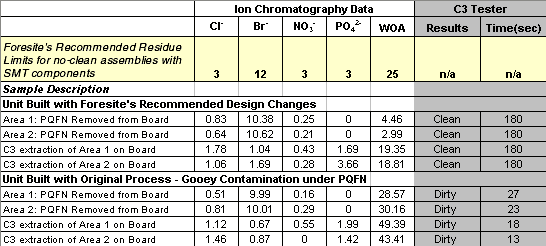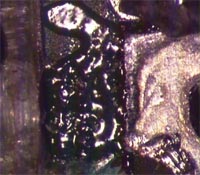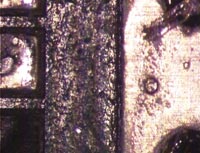2005 Articles
Escape Artist
Design changes involving a standoff permit flux trapped under PQFNs to volatilize and escape.
In my last column (“On a Flat Note,” September 2005), I discussed an assembler’s problem with flux entrapment under PQFN components. PQFNs were entrapping flux residues by not permitting a path of volatilization for the no-clean flux. Ultimately, these assemblies were failing in the field, due to stray voltage causing LEDs to remain on. Based on our failure analysis, it was definitively found that this entrapped flux was the primary contributor to the field failures, and that fabrication residues played no significant role. We were then asked to develop a corrective action plan to prevent future field failures, and recover the contaminated assemblies through rescue cleaning.
This customer implemented several corrective actions suggested by Foresite in order to prevent the flux entrapment. The first action involved the design of a standoff to support the PQFN part during reflow. Under previous design conditions, the PQFN package sat atop solder paste at a 0.006" stencil thickness, and as the solder paste entered its molten phase, was allowed to sink down to 0.003" to 0.004". This created the opportunity for flux to sink over, becoming entrapped underneath the package, where it could not become complexed and released. To remedy this situation, we suggested a design modification in which 0.005" standoffs were designed to fit into the vent pipe vias. These standoffs would physically hold up the parts, not permitting columns of solder to collapse under the parts. A second design change we suggested was to remove some of the pads from underneath the PQFNs. Fewer pads means less opportunities for contamination. We also suggested widening the gap between the power and ground. This wider spacing decreases the risk of bridging. In addition, we suggested closer monitoring of solder paste deposition, and the use of less solder paste.
To analyze whether these suggested changes were effective in eliminating the problem of gooey contamination under the PQFN parts, Foresite analyzed samples manufactured with the original process and compared them to assemblies manufactured with the suggested design changes. As seen in the analysis from last month’s column, the original process produced assemblies with high amounts of weak organic acid (WOA) flux residues, and exhibited a thick, gooey flux residue underneath the PQFN components. This held true in our followup analysis of the original process, but the assemblies built with the suggested design changes, including the standoffs and modified spacing and pad placement, showed acceptably low levels of WOA residues. The flux residue was able to volatilize under these conditions, and all ionic residue levels for these assemblies fell within Foresite’s recommended limits for reliable field performance (Table 1).

Our ion chromatography findings were very encouraging, but we still had to determine whether the assemblies built with the old manufacturing process with entrapped flux under PQFNs were recoverable. Foresite was able to develop a localized recovery cleaning protocol to clean only the PQFN area of the contaminated assemblies. Through the use of localized deionized steam cleaning with a good saponifier, we were able to effectively remove the harmful WOA residues and gooey flux that was entrapped underneath the PQFN components. Based on a followup proof of cleaning investigation, it was found that this cleaning protocol produced results well below our recommended ionic residue limits for reliable field performance of a no-clean assembly (Figures 1 and 2).
|
When contamination is creating reliability problems, flux residues are often the culprit. We reiterate how important it is to fully volatilize fluxes to avoid costly field returns. In this case, a few design changes were able to correct the problem, and localized steam cleaning was able to recover the contaminated products. Understanding processing residues and their sources can prevent these issues from happening in the first place.
Terry Munson is with Foresite Inc. (residues.com); tm_foresite@residues.com. His column appears monthly.
Press Releases
- Tagarno Sees Strong US Sales Growth in 2025, Driven by T50 and Software Demand
- Kimball Electronics Sets Date for Ribbon-Cutting at New Indianapolis Medical Manufacturing Facility
- Nordson’s SELECT Synchro Selective Soldering System Helps Kamstrup Advance Automation, Increase Output 20%, and Reclaim 6 Meters of Factory Floor Space
- Pinnacle Technology Group, Now PTG Electronics, Launches New Brand Identity, Strengthening Its Commitment to Innovation and Progress


 FIGURE 1: Assembly under PQFN area before cleaning: 120 µg/in2 WOA.
FIGURE 1: Assembly under PQFN area before cleaning: 120 µg/in2 WOA. FIGURE 2: Assembly under PQFN area after steam-cleaning: 7.23 µg/in2 WOA.
FIGURE 2: Assembly under PQFN area after steam-cleaning: 7.23 µg/in2 WOA.




